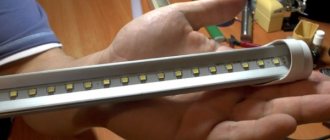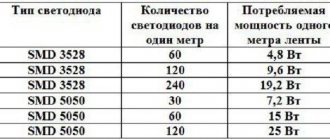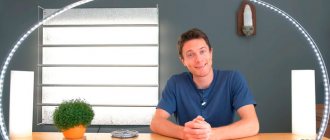Modern design solutions often use strips with diodes. For proper operation of the backlight, it is recommended to select batteries with the required parameters. In the article we will tell you in detail how to choose a power supply for an LED strip based on a number of criteria, and also show you how to correctly calculate the required power - after which we suggest you make the calculation using our online calculator and choose a transformer in our store.
Basic parameters when choosing batteries
Transformers are blocks that are responsible for the operation of the backlight by converting voltage from the network. Often LED backlighting is powered by 12 or 24 volt units. Before choosing a transformer for the LED strip, you must also consider the following parameters:
- indicator of protection from environmental influences;
- transformer operating voltage;
- backlight lengths;
- power consumed per 1 meter of illumination;
- battery dimensions.
Using elements with insufficient power ratings increases the likelihood of the tape overheating. A constant increase in temperature will lead to early failure. Since the unit operates at maximum power, the tape may burn out. Even aluminum profiles, which contribute to additional heat dissipation, will not help maintain the service life of the backlight if the transformer power is insufficient.
If the user does not know how to choose the right power supply or transformer for the LED strip and calculate the necessary parameters, it is recommended to use a calculator. It sets LED lighting indicators. Next, the system will display the necessary parameters.
Purpose of the power supply
When using LED strips in interior design, it is necessary to take into account some features of this solution.
First of all, you should know that you won’t be able to directly connect an LED strip to a socket like a regular light bulb. This is due to the fact that the operating voltage of the tape is far from 220 V. If you plug it into a regular outlet, it will simply fail.
So, if a regular incandescent lamp runs on 220 V, then LEDs require only 12 V (this is the most common option, but there are also 24-volt models). Therefore, in order to connect a 12-volt lighting fixture to a standard household network, you need to reduce the voltage to the required value. A power supply for a 12V LED strip can cope with this task .
Selecting a transformer for LED strip
LED backlighting requires the correct choice of battery. The cooling of the transformer, the degree of safety and the installation location depend on it. Next, we’ll talk about each indicator to ensure maximum safety during operation and heat dissipation.
Operating voltage
Transformers with operating values of 12 and 24 V are most often used. Power for a large section of the tape is provided by 36V units. The voltage value must match the output value of the transformer.
There are blocks in which several channels are located, allowing you to power 2 or more backlights. Also, this type of transformers is used when connecting several strips in series to illuminate the entire perimeter of a room. It can be used to power the strip used as the main source of lighting, as well as additional lighting.
What does the power supply do?
The power supply is used not only in lighting equipment, but in most common electrical appliances: TV, computer, washing machine, printer and others. The power supply for the LED strip converts the voltage received from the network to the required parameters. This ensures safety and stabilization of the operation of the electrical appliance. In our case, the power supply receives 220 Volts, and transmits only 12 V to the lighting device (the most popular option). Without the block, all this power would fall on the tape, and the device simply would not withstand such a load.
Kitchen lighting
Will decorate your kitchen. Use our designer to choose your lighting set in a couple of minutes.
More details
How to choose a power supply for LED strip according to the degree of protection
Depending on the room in which the LED strip will be installed, a power supply with a certain degree of protection is selected. This parameter is indicated by two letters IP and a number that corresponds to the degree of moisture protection. There are batteries with the following indicators:
- IP20. Batteries with this indicator are suitable for installing the tape in rooms where the risk of mechanical stress is minimal. Do not come into contact with water. There is protection against small objects of at least 12.5 mm. Suitable for lighting in the living room, bedroom, children's room.
- IP65. Transformers with this degree of protection are suitable for installation in the kitchen. They are protected from water jets and dust. However, it should not be installed outdoors or in rooms with high humidity. They do not withstand prolonged contact with water.
- IP67. These blocks are completely sealed and can withstand immersion under water up to 1 meter. Suitable for use in bathrooms, kitchens and outdoors. They do not fail when exposed to drops of water or fine dust. If the user needs to install the tape at a greater depth, use IP69 transformers that have maximum tightness.
It is important to choose a protection level that is the same as that of an LED strip. If you install elements with different values, one of them may fail before the other, given the common environment in which they are located.
Dimensions
The dimensions of the transformer depend on the room and surrounding objects. Provide free space near the unit for additional cooling and air circulation. Large transformers should not be installed near equipment that generates heat. Additional heating contributes to early burnout of diodes.
On units with high power, cooling elements are often installed. It is recommended to choose transformers in which the cooler is located perpendicular to the board elements.
RGB strip allows you to change the color lighting in the room depending on your mood. To use the remote control to change colors, a dimmer or controller is placed between the block and the tape. For a good signal from the remote control, it is recommended to install it in an accessible place. Install a transformer for RGB LED strip indoors with minimal risk of mechanical damage.
Price of power supply for 12V LED strip
You can buy a power supply for a 12V LED strip not only at lighting equipment sales points, but also on the web pages of manufacturers and organizations selling LED products. There you can familiarize yourself with the range of converter models, their technical characteristics and the cost of the units.
By contacting site managers, you can get professional advice on how to choose a power supply for an LED strip, depending on its type and operating conditions. Experienced specialists will help you choose the right device that will ensure durable and high-quality operation of the LED structure. As a rule, all products are certified and provided with a guarantee from the manufacturer.
Each LED produces a light intensity of about 3-21 lumens with a maximum power consumption of 19.8 watts
Note! When purchasing an open type converter, remember that it can only be used in rooms with a minimum degree of humidity and in places where there is no risk of water ingress.
Before you buy a power supply for an LED strip, it is worth reviewing the cost of products offered by different companies. This will help in choosing a model with the necessary parameters on favorable terms. Approximate prices of power supplies for 12V LED strip are presented in the table:
| Converter model | Dimensions, mm | Main settings | price, rub. |
| Interior power supply 12V 15W IP 20 | 70/39/30 | Supply voltage 110-220V, power 15W, equipped with a power indicator and voltage regulator | 270 |
| PSU 12V 35W IP 20 | 85/58/32 | Supply voltage 110-220V, power 35W, has a power indicator and voltage regulator | 380 |
| PSU 12V 60W IP 20 | 159/98/38 | Supply voltage 110-220V, power 60W, has a power indicator and voltage regulator | 540 |
| PSU 12V 150W IP 20 | 200/89/40 | Supply voltage 110-220V, power 150W, equipped with power indicator and voltage regulator | 780 |
| PSU waterproof 12V 30W IP 67 | 220/28/20 | Supply voltage 110-220V, power 30W, protection from moisture and dust | 560 |
| PSU waterproof 12V 60W IP 67 | 148/40/30 | Supply voltage 110-220V, power 60W, protection from moisture and dust | 1100 |
| PSU waterproof 12V 100W IP 67 | 202/71,2/45 | Supply voltage 110-220V, power 100W, protection from moisture and dust | 1670 |
Sometimes there are situations when it is necessary to highlight a small area. Then purchasing a power supply will cost much more than purchasing the tape itself. In this case, you can make the converter yourself.
How to choose a power supply for an LED strip - calculation method
Independent calculation of the required indicators is carried out according to the formula: N=L*U*K, where N is the calculated power, U is the consumed power of the tape, calculated per 1 meter, L is the length of the LED backlight with diodes, K is the safety factor (20%).
The calculation takes into account the safety factor. Part of the energy is spent on losses in the wires during operation of the tape. If you do not take this coefficient into account, the power supply will operate at maximum power, which will lead to heating of the element. In the worst case, a short circuit will occur and the backlight will malfunction.
To make the right choice of indicators, it is recommended to use a calculator for calculating the power supply for an LED strip. A transformer with correctly selected power will ensure stable operation of LED lighting in the room, reducing the likelihood of diodes overheating. We invite you to use our online calculator to calculate the power supply for the LED strip.
Types of power supplies for 12 volt LED strips
Unlike conventional incandescent lamps, LED structures cannot be connected to a 220V network. They are available with a supply voltage of 12V or 24V. 12V LED strips are most in demand as lighting in home interiors. To obtain the required voltage, special adapters are used - power supplies that convert the voltage in the 220V network to the required value of 12V.
Before choosing a power supply for an LED strip, you should familiarize yourself with their types and characteristics. Stabilizers for LED products differ according to the following criteria:
- power – 5; 15; thirty; 60; 100; 150; 200 and 350 (W);
- functionality - provide only power, with a built-in dimmer (dimmer) and/or remote control;
- cooling system – with active and passive cooling. With an active system, a fan is built into the case, which produces a certain noise, which can cause discomfort;
Power supply for LED strip 12V
- degree of protection – there are sealed and non-sealed models;
- housing design - plastic, aluminum sealed for rooms with high levels of humidity, metal with perforation and contact pads (used for dry rooms and requires installation in a closed place to avoid dust).
Voltage stabilizers are an essential element of high-quality lighting, ensuring maximum efficiency of LED light sources. They supply the LEDs with the necessary parameters of electricity, protecting them from possible power surges and premature failure. Thanks to power supplies, LED strips emit a uniform glow without flickering.
Instructions for choosing power supplies for LED strips
All LED strips are manufactured for a specific supply voltage (12 V, 24 V, 36 V, 48 V) and are powered by a stabilized voltage. Basically, LED strips with a supply voltage of 12 V and 24 V are widely used, and are more widely used with a supply voltage of 12 V DC. Accordingly, LED strips require power supplies with voltage regulation: 12 V, 24 V, 36 V, 48 V. Usually, 12 V or 24 V.
In terms of design, there are 2 types of power supplies for LED strips:
- open type, without sealing and without protection from moisture in the air
- sealed, waterproof, sealed and protected from moisture in the air.
The essence of selecting power supplies for LED strips comes down to assessing the power consumption of the connected LED strips and choosing a power supply that corresponds to this power with a certain power reserve factor. However, you should take into account the maximum current consumption from the power supply and do not exceed it. When connecting several tapes, their electrical power must be summed up and a power supply with a power reserve factor is selected for this total power.
Power reserve factor: - 1.3 (if the mode is not constant, short-term operating mode, then turns on and off, and the shutdown time is longer than the operating time) -1.5 (if the operating mode is constant, that is, the LED strip is constantly connected to the power supply and it works) Example 1. We have one LED strip and need to select a power supply for it. LED strip parameters: - Supply voltage 12 V - Number of LEDs in one meter: 30 pcs/meter - Total power of LEDs in one meter of strip: 5 W/meter - Total length of the entire strip (without cuts and extensions): 10 meters Total length LED strip 10 meters, it is known that each meter of strip consumes 5 W of power. We determine the total power consumption of the entire tape: 10 meters * 5 W = 50 W Power supply unit (short-term operating mode): 50 W * 1.3 = 65 W Power supply unit (permanent operating mode): 50 W * 1.5 = 75 W If we do not know what operating mode is planned by the customer, then accordingly we take the maximum calculated power for a constant operating mode of 75 W. Next, we look at what power supplies we have in terms of power from standard ones manufactured by suppliers. If there are power supplies with a standard power of 75 W, then choose them. If there are no power supplies specifically for 75 W, but there are 68 W and 80 W, then choose a higher power of 80 W (but in no case a lower power of 68 W). Total: based on the calculation result, we chose a power supply with a power of 75 W with a supply voltage of 12 V (if there is one that is standardly produced) Or 80 W with a supply voltage of 12 V (if 75 W is not produced as a standard) Example 2. We have 3 LED strips and need to be powered them together and select a power supply for them. Parameters of each LED strip: - Supply voltage 12 V - Number of LEDs in one meter: 30 pcs/meter - Total power of LEDs in one meter of strip: 5 W/meter - Total length of the entire strip (without cuts and extensions): 10 meters Total The length of the LED strip is 10 meters, it is known that each meter of strip consumes 5 W of power. We determine the total power consumption of the entire tape: 10 meters * 5 W = 50 W Since we have 3 tapes and need to be powered together, they will need to be connected to the power supply in parallel (we use a power supply with voltage stabilization) - that is, when connecting three tapes, their electrical powers add up. Total power consumption by 3 tapes: 50 W * 3 = 150 W Power supply unit (short-term operation): 150 W * 1.3 = 195 W Power supply unit (permanent operation): 150 W * 1.5 = 225 W If We do not know what operating mode is planned by the customer, so accordingly we take the maximum calculated power for constant operating mode 225 W. Next, we look at what power supplies we have in terms of power from standard ones manufactured by suppliers. If there are power supplies with a standard power of 225 W, then choose them. If there are no power supplies specifically for 225 W, but there are ones for 215 W and 240 W, then choose a higher power of 240 W (but in no case a lower power of 215 W). Total: according to the calculation result, we chose a power supply with a power of 225 W with a supply voltage of 12 V (if there is one that is standardly produced) Or 240 W with a supply voltage of 12 V (if 225 W is not produced as standard) Note: Power supplies up to 300 W inclusive are widespread , power supplies for 600 W, 800 W, 1000 W are less common, but they are usually much more expensive. All tapes are connected to the power supply in parallel: all positive terminals of the tapes are connected to each other and connected to the plus power supply, all negative terminals of the tapes are connected to each other and connected to the minus of the power supply. The total power consumed by LED strips from the power supply should always be 1.3-1.5 times less than the power of the power supply.











